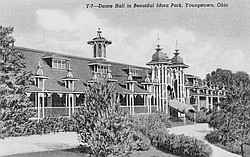Idora historian revives memories of Youngstown’s amusement park
Idora Park

By WILLIAM K. ALCORN
alcorn@vindy.com
YOUNGSTOWN
There were smiles and nods of remembrance and appreciation all around the room as Youngstown State University English professor Rick Shale talked about the rides and the biggest of the big bands and entertainers that made Idora Park the place to go here for 85 years.
There were the aptly named Wildcat roller coaster and the famous Idora Park Carousel, now Jane’s Carousel named after Jane Walentas who purchased and spent 22 years restoring it after it was damaged in 1984 in a fire at the park.
Shale said there were some 20 nationality and ethnic days a year at Idora.There were so many Italians in Youngstown that three groups of Italians celebrated their heritage annually.
“We had a Polish Day,” said Bill Tabaka of Boardman, who grew up in New Middletown. His said his favorite rides were the Jack Rabbit and bumper cars.
The Jack Rabbit, a wooden roller coaster, was built in 1910 and had a ride time of two minutes and thirty seconds. As an adult, Tabaka said he went to the Idora Ballroom to listen and dance to the big-name big bands of the era.
“It brings back fond memories,” he said.
John and Dorthea Ulrich Becker, who grew up in Youngstown and live in McDonald, said they danced at the ballroom to Guy Lombardo and Tommy Dorsey and other big bands.
Becker, who worked for Ohio Edison, said they took their six children to Idora for the company picnic. “We always had a good time.”
Waldean Thorndell of Youngstown, who grew up on Warren Avenue, had passes for the swimming pool and said she really enjoyed the roller coaster. “On 3-cent days, we’d ride it over and over again to see how many times we could,” she said.
“One girl had a car, and eight of us would pile in to go to dancing at the Idora Ballroom,” said Anne Vianello of Youngstown. “We saw Frank Sinatra. It was a great place,” she said.
Eileen Duffy, coordinator of marketing and admissions at Park Vista, had an insider perspective of Idora Park; her grandfather, Patrick Duffy Sr., was president and part-owner followed by her father, Patrick Duffy Jr.
Eileen and her brothers, Patrick III and Michael, and sister Kathleen West, all worked at the park, Eileen from age 15 until it closed in 1984, in such venues as the candy apple and popcorn stand, the Lost River water ride and Cheyenne Shootout, a western shooting gallery.
“It was good for people-watching, and the picnics were always fun. We worked all day and got all sweaty and then we’d sneak into the ballroom and watch the bands. That’s how I learned to jitterbug,” she said.
“What was way cool for a teenager was that I got to meet David Cassidy and the Monkees, Bobby Sherman and Maynard Ferguson and lots of others,” she said.
“We should be sorry it closed, but we should also celebrate that it lasted as long as it did,” said Shale. He attributed Idora’s longevity, including through the Great Depression when a majority of amusement parks closed, to strong local leadership, including the Duffys.
Shale said the company picnics generated 50 percent of Idora’s revenue.
Idora, which became popularly known as Youngstown’s Million Dollar Playground, opened on May 1, 1899, which was then called Decoration Day.
It was built by the Youngstown Park and Falls Street Railway Co. and named Terminal Park because that is where the trolley tracks ended. In the early days, most people either walked or took the trolley to the park. It was later renamed Idora. The park closed in 1984 after a fire damaged or destroyed several major attractions.
Shale said there are several theories about the origin of the Idora name, but none is definitive.
“My best guess is that Idora is a Native American word,” said Shale, who has co-written “Idora Park: The Last Ride of Summer” with Charles J. Jacques Jr.
Shale said not everybody remembers that many sporting events occurred at Idora, including boxing, wrestling and baseball.
He said professional teams played exhibition games at Idora while traveling between cities, and that once the Cleveland Indians Hall of Famer Earl Averill hit a home run that went into or over the Jack Rabbit.
The Negro League professional baseball teams also played there regularly, he said.
Idora attracted people from all social and economic classes. Immigrants who came to Youngstown to work in the steel mill did not have to speak English to enjoy it. The park was a place where the rules could be broken, said Shale who wore a shirt with a message: “Idora: Still Open in Our Hearts.”
“It’s kind of how we feel. I love to talk to audiences whose members are old enough to have Idora memories,” he said.
“Idora is in our minds and hearts so much because we have happy memories of a time when families did things together and you didn’t have to lock your doors, and Youngstown was more prosperous,” Shale said.
 43
43
